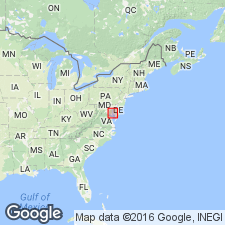
- Usage in publication:
-
- Fairhaven diatomaceous earth member*
- Modifications:
-
- Named
- Dominant lithology:
-
- Diatomite
- Sand
- AAPG geologic province:
-
- Atlantic Coast basin
Summary:
Fairhaven diatomaceous earth member (new name) of Calvert formation is characterized by presence of large proportion of diatoms embedded in a very finely divided quartz matrix. Contains only small amount of calcareous material. Consists of (descending) 20 ft of diatomaceous earth; 1 ft white sand, locally indurated to sandstone; and 2 to 6 ft of brownish sand. Age is Miocene.
Source: GNU records (USGS DDS-6; Reston GNULEX).
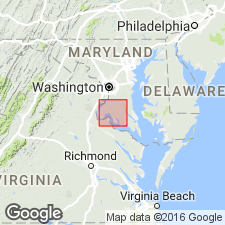
- Usage in publication:
-
- Fairhaven member
- Modifications:
-
- Revised
- AAPG geologic province:
-
- Atlantic Coast basin
Summary:
Unit described in Charles Co., MD, where it is about 75 ft thick at Popes Creek. Of this total, only one bed, 17 ft thick, contains a significant proportion of diatoms. It is suggested here that term Fairhaven member be used for lower part of Calvert formation and "diatomaceous earth" or "diatomite" be reserved for the one bed containing a high percentage of diatoms. Age is middle Miocene.
Source: GNU records (USGS DDS-6; Reston GNULEX).
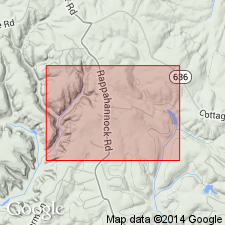
- Usage in publication:
-
- Fairhaven Member*
- Modifications:
-
- Revised
- AAPG geologic province:
-
- Atlantic Coast basin
Summary:
Fairhaven Member of Calvert Formation geographically extended into northeastern VA.
Source: GNU records (USGS DDS-6; Reston GNULEX).
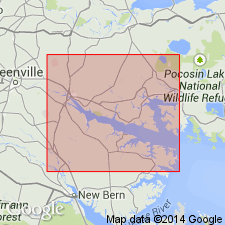
- Usage in publication:
-
- Fairhaven Member*
- Modifications:
-
- Revised
- AAPG geologic province:
-
- Atlantic Coast basin
Summary:
Advance copy (1978). Fairhaven Member of Calvert Formation. Restricted to the sandy and muddy diatomaceous strata; the lower muddy sand beds reallocated to newly named Popes Creek Sand Member.
Source: Modified from GNU records (USGS DDS-6; Reston GNULEX).
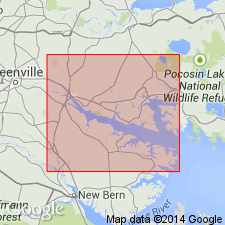
- Usage in publication:
-
- Fairhaven Member*
- Modifications:
-
- Age modified
- AAPG geologic province:
-
- Atlantic Coast basin
Summary:
Advance copy (1978). Fairhaven Member of Calvert Formation. Age changed from early and middle Miocene --to-- early Miocene. [This manuscript was reviewed by GNU in June, 1978.]
Source: Modified from GNU records (USGS DDS-6; Reston GNULEX).
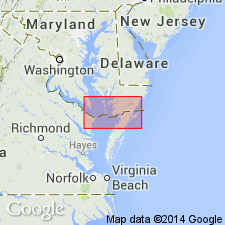
- Usage in publication:
-
- Fairhaven Member*
- Modifications:
-
- Areal extent
- Dominant lithology:
-
- Sand
- AAPG geologic province:
-
- Atlantic Coast basin
Summary:
Data from the section in the Haynesville coreholes, 0.65 mi northwest of Haynesville, (lat 37 deg 57'13" N, long 76 deg 60'26" W), Richmond Co., VA. The lower shelly sand beds of the Calvert Formation are equivalent to the upper Fairhaven Member or the lower Plum Point Marl Member in Maryland. Overlying the shelly sand beds are 7 phosphatic diatomaceous fining-upward sequences. The lower two are named the informal Plum Point marl beds, equivalent to the Plum Point Marl Member in Maryland. The upper 5 sequences are named the informal Calvert Beach beds, equivalent to the Calvert Beach Member in Maryland.
Source: GNU records (USGS DDS-6; Reston GNULEX).
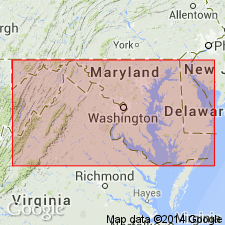
- Usage in publication:
-
- Fairhaven Member
- Modifications:
-
- Revised
- AAPG geologic province:
-
- Atlantic Coast basin
Summary:
Name Popes Creek Sand Member for bed at the base of Calvert Formation is discarded, and these strata are reassigned to the Fairhaven Member. Though a phosphate pebble lag indicates an unconformity, diatomaceous clays on either side of that contact are so similar that they cannot be separated lithologically. Age of Fairhaven is lower and lower middle Miocene.
Source: GNU records (USGS DDS-6; Reston GNULEX).
For more information, please contact Nancy Stamm, Geologic Names Committee Secretary.
Asterisk (*) indicates published by U.S. Geological Survey authors.
"No current usage" (†) implies that a name has been abandoned or has fallen into disuse. Former usage and, if known, replacement name given in parentheses ( ).
Slash (/) indicates name conflicts with nomenclatural guidelines (CSN, 1933; ACSN, 1961, 1970; NACSN, 1983, 2005, 2021). May be explained within brackets ([ ]).

